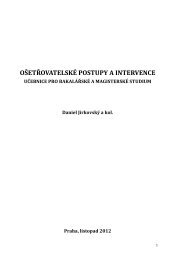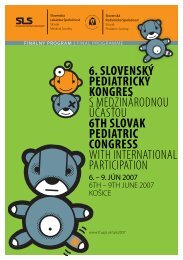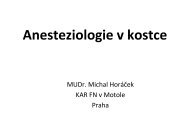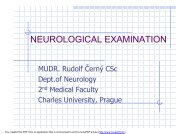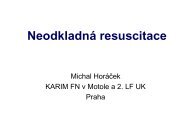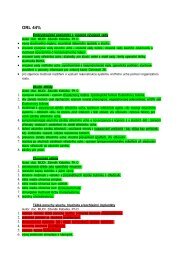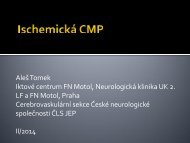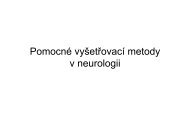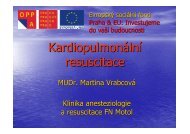Zde - 2. lékařská fakulta - Univerzita Karlova
Zde - 2. lékařská fakulta - Univerzita Karlova
Zde - 2. lékařská fakulta - Univerzita Karlova
Create successful ePaper yourself
Turn your PDF publications into a flip-book with our unique Google optimized e-Paper software.
P-60. AUTOLOGOUS HUMAN PERICARDIUM, A NEW APPROACH FOR HEART VALVE TISSUEENGINEERINGStraka F 1 , Schornik D 2 , Filova E 2 , Masin J 1 , Burdikova Z 3 , Mirejovsky T 1 , Chlup H 4 , Horny L 4 , Vesely J 4Pirk J 1 , Bacakova L 21 Institute for Clinical and Experimental Medicine, Prague, Czech Republic; 2 Department ofBiomaterials and Tissue Engineering Institute of Physiology Prague, Czech Republic; 3 Department ofBiomathematics, Institute of Physiology, Prague, Czech Republic; 4 Laboratory of Biomechanics,Faculty of Mechanical Engineering, Czech Technical University in Prague, Czech RepublicSupervisor: Prof. MUDr. Jan Pirk, DrSc.Introduction: Several methods are possible to constructing a heart valve in the laboratory usingdifferent types of scaffolds, a variety of cells and conditioning protocols.Aims: Our objective is to construct a living autologous human pericardial heart valve for clinical usepossessing mechanical properties similar to the aortic heart valve, with a similar histological structureand remodeling potential.Materials and Methods: Human pericardium samples were harvested during cardiac surgery andattached onto a plastic holder in the shape of the normal three cusp aortic heart valve. These scaffoldswere cultured under dynamic conditions for up to four weeks. After this time conditioned pericardialsamples were compared to control unconditioned pericardial samples from the same patient. Both ofthese tissues were compared with the normal aortic heart valve obtained during heart transplantation.Histological, immunohistochemical and biomechanical assessments were performed on all samples.Results: Normal human pericardium consists of vimentin positive pericardial interstitial cells (PICs)that have similar properties to valvular interstitial cells (VICs). These cells are able to respond tomechanical stresses by proliferating and differentiating into an active phenotype capable of producingnew extracellular matrix (ECM). This was shown by a significant increase in alpha – smooth muscleactin and Ki 67 positive cells after conditioning, as well as by increased collagen, elastin andglycosaminoglycan production. The histological structure of the conditioned pericardium is very similarto the normal aortic heart valve and dynamic conditioning was proven to be important for PICactivation. Uniaxial tensile tests were performed in order to compare the mechanical properties ofconditioned pericardium with the native aortic heart valve. Our results indicate that the secant elasticmodulus of pericardium before and after conditioning is comparable to the native aortic heart valve.Conclusions: Our study demonstrated the potential of living autologous human pericardium to mimicthe natural extracellular matrix structure, mechanical properties and interstitial cell phenotypic activityof the normal aortic heart valve making human pericardium a promising tissue from which to constructa living heart valve replacement. Such a pericardial heart valve possesses optimal hemodynamicproperties and may be capable of remodeling and regenerating in vivo.Support: The Grant Agency of the MH of the Czech Republic, project No. NT 11270.92



